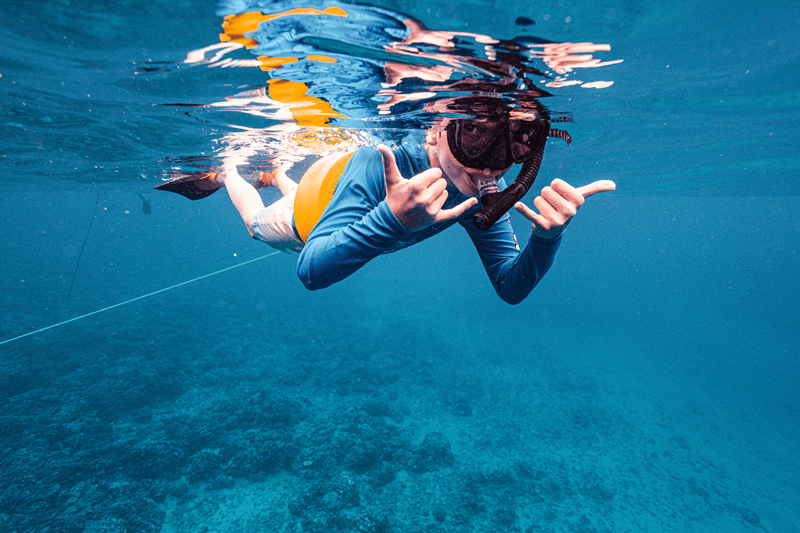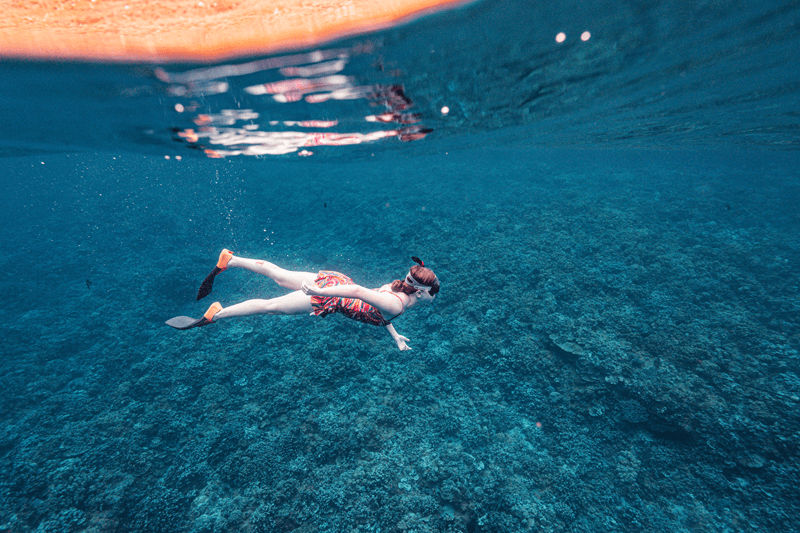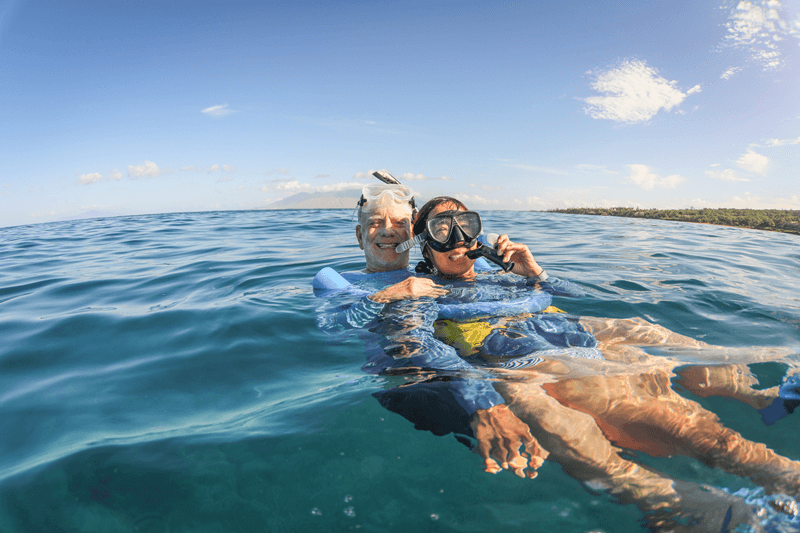Snorkeling on Maui is one of the easiest—and most rewarding—ways to see Hawaiʻi’s underwater world. You don’t need scuba certification to get started; just a calm bay, a well‑fitting mask, and a few basics from this guide.
As you explore, remember to give wildlife room: NOAA recommends staying at least 10 feet (3 m) from sea turtles (in the water and on shore). And because Hawaiʻi restricts the sale of sunscreens with oxybenzone and octinoxate, pack a mineral sunscreen (zinc oxide or titanium dioxide) to protect both your skin and the reef.
For the smoothest experience, go early in the morning when winds and surface chop are typically lighter, then choose a beach that matches the day’s wind and swell. Our quick Maui Snorkel Conditions 101 shows you exactly how to check wind, swell, and water‑quality advisories in 5 minutes. If you’d rather let a captain do the reading for you, the Molokini Crater Snorkeling Tour hits Maui’s clearest water—often before the trades ramp up.
If you’ve never snorkeled before (or it’s been a while), don’t worry — this snorkeling for beginners guide covers everything you need to know, from choosing the right gear to finding beginner-friendly beaches and staying safe in the ocean!
Why Maui Is Perfect for First-Time Snorkelers
are known for gentle entry points, clear visibility, and warm water year-round. You can step right into the ocean from the sand and see tropical fish within minutes—which makes it perfect for snorkeling for beginners.
What makes Maui ideal:
- Calm conditions on the south and west shores
- Plenty of protected bays and coves
- Lifeguards at several beaches
- A variety of tours for every skill level
Whether you’re exploring Kapalua Bay, Napili Bay, or joining our Molokini Crater Snorkeling Tour, there’s no better place to start your underwater adventure!
What to Expect When You First Start Snorkeling
Snorkeling is simple once you get the hang of it. You’ll float on the surface, breathing through your snorkel, while watching marine life below. Below are some snorkeling tips for beginners.
Your first time will involve:
- Putting on a mask and adjusting the strap to fit snugly
- Biting gently on the snorkel mouthpiece
- Floating face down while breathing slowly through your mouth
- Kicking lightly with fins to move around
- Relaxing and letting the water support you
The key is to stay calm, move slowly, and take deep, steady breaths. Once you find your rhythm, you’ll be amazed at how peaceful and effortless it feels—especially at Maui’s top spots for snorkeling for beginners.
Ready to experience Maui’s clearest water?
Book your Molokini Crater Snorkeling Tour today and explore one of the most beautiful reefs in Hawaii—a favorite among first-time snorkelers and families looking for the best snorkeling for beginners.
👉 Reserve your spot now — spaces fill fast!
Seasonality & Conditions (Quick Guide)
- Time of day: Mornings (roughly 7:00–10:30 a.m.) usually bring lighter winds and clearer surface water; trades and sea‑breeze effects tend to build into midday. Cross‑check the day’s wind/swell before you go. See Maui Snorkel Conditions 101.
- Winter (Nov–Apr): North & West shores often feel larger north‑Pacific swells; choose protected leeward coves or go offshore to Molokini’s inner crater for clarity. Always match your spot to the swell direction.
- Summer (May–Oct): South swells become more frequent, so check exposure on South Maui beaches. West Maui and some northern pockets can be calmer when south swells are up—again, verify the day’s direction.
- Always check the “big three”: (1) NOAA Marine Forecast/point forecast for wind and any advisories; (2) Hawaiʻi DOH Clean Water Branch for brown‑water advisories after rain; (3) Hawaiʻi Ocean Safety for lifeguarded‑beach hazard updates.
- Deep dive: Compare mornings vs afternoons in Morning vs Afternoon Snorkeling; then keep the 5‑minute conditions checklist handy.
Must-Have Gear for Beginner Snorkelers
You don’t need much equipment to snorkel in Maui, but having the right gear makes a big difference.
Basic Snorkel Gear Checklist:
- Mask: Should fit snugly without leaks. Press it to your face and inhale gently — it should stay in place without the strap.
- Snorkel: Choose one with a purge valve (makes it easy to clear water) and a splash guard (keeps waves out).
- Fins: Help you move efficiently through the water without using too much energy.
- Rash guard or short wetsuit: Protects you from sunburn and jellyfish stings.
- Floatation vest or noodle: Keeps you buoyant and confident if you’re new to swimming.
If you join one of our Maui Snorkeling Tours, all the gear is provided — cleaned, fitted, and ready to go. You just show up and enjoy!
Where to Snorkel in Maui for the First Time
Not every beach in Maui is beginner-friendly. Some have rocky entries, strong currents, or deeper drop-offs. Stick to calm, protected bays — especially in South and West Maui, where the ocean is usually calmer.
Map & Parking Basics: 4 Easy Beaches for Beginners
Parking is limited island‑wide—arrive early, especially in West Maui. Facilities and lifeguard coverage vary by beach; when in doubt, choose a lifeguarded beach or join a guided tour.
Kapalua Bay (West Maui)
- Why it’s great: Sheltered crescent with sandy entry; work the rocky edges for fish.
- Best window: Early morning (<10:30 a.m.) for lighter wind/clearer water.
- Facilities: Restrooms & outdoor showers; no lifeguard.
- Parking: Small beach‑access lot; additional paid/overflow near Kapalua Tennis Garden; street parking on Lower Honoapiʻilani Rd (observe signage).
- Season note: Can feel winter north/west swells—skip on rough days.
Napili Bay (West Maui)
- Why it’s great: Small, scenic bay with easy entry; popular with families.
- Best window: Early morning before winds/crowds.
- Facilities: Showers; no lifeguard; no public restrooms (restrooms may be inside nearby private facilities).
- Parking: Street parking along Hui Dr / Lower Honoapiʻilani Rd; arrive early.
- Season note: More exposed to winter surf—avoid if shorebreak is up.
Ulua Beach (South Maui)
- Why it’s great: Beginner‑friendly, sandy entry with reef fingers close to shore; popular training site.
- Best window: Morning for calmer winds and clearer visibility.
- Facilities: Restrooms & showers by the parking area; no lifeguard.
- Parking: Dedicated lot shared with Mokapu; fills fast on weekends.
Māluaka Beach (“Turtle Town,” South Maui)
- Why it’s great: Reliable calm mornings and frequent honu (sea turtle) sightings; follow turtle‑viewing rules.
- Best window: Morning; skip after heavy rain or when surf is up.
- Facilities: Restrooms & showers near the north lot by Keawalaʻi Church; no lifeguard.
- Parking: Two public lots (north by the church; larger south lot at road’s end); short walk to sand.
Tip:
If the parking is full or the bay looks rough, pivot. Your conditions check plus a quick drive to a more protected cove can save the day.
When to Snorkel: Timing Matters
The best snorkeling conditions happen early in the morning — usually between 7:00 AM and 10:30 AM. During this time:
- Winds are lighter
- The water is clearer
- Fewer people are in the water
- Marine life is more active
By midday, trade winds can create choppy waves and reduce visibility. So if you want calm seas and bright underwater colors, go early.
Tip: Check out our Morning vs Afternoon Snorkeling Maui guide for more information!
How to Stay Safe in the Ocean
The ocean is beautiful but powerful. Respecting it is the key to a safe and enjoyable experience.
Safety Tips for Beginners:
- Always snorkel with a buddy. Never go alone.
- Check ocean conditions before heading out. Avoid high surf or murky water.
- Start in shallow water and practice breathing before swimming far.
- Stay close to shore where you can easily stand or rest.
- Avoid touching coral or stepping on rocks — they’re sharp and fragile.
- Keep a respectful distance from sea turtles, fish, and other marine life.
- Use reef-safe sunscreen (zinc oxide or titanium dioxide only).
- Know your limits. If you’re tired, rest — don’t push it.
Hawaii’s ocean safety slogan says it best: “If in doubt, don’t go out.”
Snorkeling Etiquette: Respect the Reef
Maui’s coral reefs are living ecosystems that take hundreds of years to grow — and just seconds to damage. Follow these simple rules to protect them for future generations.
Reef Etiquette 101:
- Don’t stand, touch, or kick coral.
- Use mineral-based sunscreen to avoid chemical damage.
- Don’t chase or feed fish and turtles.
- Collect only memories — never shells or coral.
- Be aware of your fins so you don’t accidentally kick the reef.
Practicing good snorkeling etiquette keeps Maui’s reefs healthy — and helps you enjoy a more authentic connection with nature.
Molokini Snorkeling
Your Maui adventure starts at Molokini! Jump into turquoise water, glide over colorful coral, and snorkel inside a volcanic crater with unbeatable visibility.
👉 Grab your spot now and make your trip one to remember!
Common Snorkeling for Beginners Mistakes (and How to Avoid Them)
Even seasoned swimmers make rookie mistakes their first time snorkeling. Here’s what to watch out for:
| Mistake | How to Fix It |
|---|---|
| Mask fogs up | Rub a drop of baby shampoo inside and rinse lightly before wearing |
| Water in snorkel | Blow firmly through the snorkel to clear it (purge valve helps) |
| Panic when breathing | Practice breathing through the snorkel before entering deep water |
| Cramped legs | Kick gently and relax your legs instead of tensing them |
| Drifting too far | Keep visual contact with your buddy or shoreline markers |
Practicing Before You Go
You can build confidence before your trip:
- Try snorkeling in a hotel pool or calm lagoon
- Practice floating face down and breathing through the snorkel
- Get comfortable with your fins and mask fit
A little practice goes a long way toward making your first ocean experience relaxing and fun.
Non‑swimmers & kids: how to start (safely)
- Practice on land & in the shallows. Get used to breathing through the snorkel with your face in a sink/tub, then practice floating in waist‑deep water before you venture out. Keep the first session to 20–30 minutes.
- Use flotation. A USCG‑approved Type III life jacket is the most supportive option for weak swimmers. A snorkel vest or belt adds surface buoyancy but is not a USCG‑approved life jacket. Choose what keeps the swimmer comfortably afloat and visible.
- Buddy system, always. Never snorkel alone; designate an adult “water watcher” who is focused on supervision (no phones).
- Pick the easiest conditions. Go early when winds are lighter, choose a sandy entry in a protected bay, and stay where you can easily stand up. Skip it if there’s surf, surge, murky water, or a brown‑water advisory.
- Kid‑specific basics. Constant, close adult supervision; consider a USCG‑approved life jacket for kids and weak swimmers even in shallow water; keep sessions short and warm (rash guard).
Beginner Spot Snapshots: When to Skip
Use this quick “not‑today” guide alongside your daily conditions check.
- Kapalua Bay (West Maui): Skip during large north or west swells (common in winter) or when afternoon trades kick up surface chop.
- Napili Bay (West Maui): Skip with winter north/west swells or strong shorebreak.
- Ulua Beach (South Maui): Skip after heavy rain (brown water) or when strong afternoon winds make surface conditions bumpy.
- Māluaka / “Turtle Town” (South Maui): Skip with south swell, strong wind, or murky water. Keep 10 ft / 3 m from turtles if you go.
Trusted Daily Condition resources
- NOAA Surf Forecast (Statewide) – official swell, wind, and hazards.
- NOAA Marine/Coastal Waters Forecast – wind/sea state by zone.
- Hawaiʻi DOH Clean Water Branch – brown‑water advisories after rain.
- Hawaiʻi Ocean Safety – safety tips, lifeguarded‑beach info.
Take the Easy Way: Join a Maui Snorkeling Tour
If you’d rather skip the stress of finding the right beach or buying gear, the Maui Snorkeling crew has you covered! Our friendly guides are experts at helping beginners feel safe and confident from the very first splash.
Morning Molokini Crater Snorkeling Tour (7 AM – 12 PM)
- Two incredible snorkel stops: Molokini Crater and Turtle Town
- All-inclusive with breakfast, lunch, and gear
- Calm, early-morning conditions — perfect for first-timers
- Swim with tropical fish and green sea turtles
- Water slide, flotation devices, and plenty of fun for the whole family
Afternoon Snorkeling Tour (1 PM – 4 PM)
- Great for a shorter adventure
- Includes lunch and snorkel gear
- Calm, colorful reefs perfect for beginners
👉 Book your tour today and experience the safest, easiest way to explore Maui’s beautiful reefs — even if it’s your first time in the ocean!
FAQs
Q: Is Molokini good for beginners?
A: Yes—inside the crescent (“inner crater”) is boat‑access only, typically sheltered, and visibility is often excellent on calm mornings. Ask us for flotation if you’re new.
Q: I’m not a strong swimmer—can I still snorkel?
A: Start in a protected, sandy bay during calm morning conditions, stay very close to shore, and use a USCG‑approved Type III life jacket or a snorkel vest for extra buoyancy. Always go with a buddy and exit at the first sign of fatigue or chop.
Q: How close can I get to sea turtles?
A: Stay at least 10 feet (3 meters) away—in the water and on shore—and never touch or feed wildlife. Use your camera’s zoom instead.
Q: What’s the best time of day to snorkel on Maui?
A: Early morning is usually best; local winds and surface chop tend to increase later in the day. If afternoon winds are up, choose a different activity or a more protected cove.
Q: Is it safe to snorkel after heavy rain?
A: Avoid brown water—the state advises staying out due to runoff that may contain pathogens, chemicals, and debris. Wait for advisories to clear and for the water to go blue/clear again.
Hawaii State Department of Health
Q: Do I need to snorkel with a buddy?
A: Yes. Hawaiʻi Ocean Safety and the National Park Service both recommend the buddy system for snorkeling. It’s safer and provides support if something changes quickly.
Q: Where can I see today’s conditions?
A: Check NOAA’s Surf Forecast and the Marine/Coastal Waters Forecast first, then look for a Maui‑specific snorkel report and talk to lifeguards at lifeguarded beaches. If it looks rough, don’t go out.
Q: What about kids?
A: Keep kids within arm’s reach, use USCG‑approved life jackets for weak swimmers, and keep sessions short in calm, shallow water. Choose mornings and sandy entries.
Final Thoughts
Maui is one of the most beginner-friendly snorkeling destinations in the world. With calm waters, friendly sea turtles, and experienced guides, you’ll quickly see why so many visitors fall in love with the island’s underwater beauty.
Start early, stay safe, and keep your eyes open — you never know what amazing creatures will swim by. Whether it’s your first snorkel or your fiftieth, Maui’s reefs always have something new to share! Mahalo for reading our Maui Snorkeling for Beginners guide! 🌊🐢




